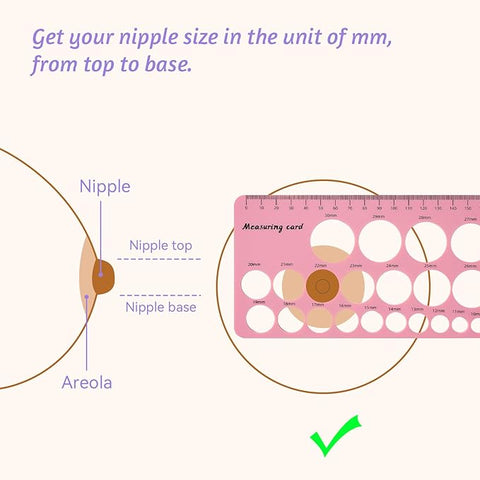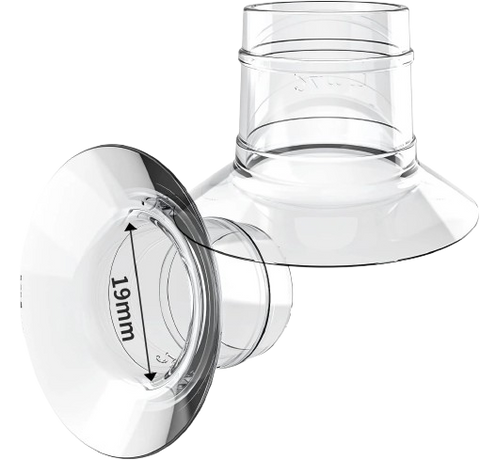Welcome to the world of breastfeeding and pumping—a journey filled with love, dedication, and the quest for the best comfort and efficiency for both you and your baby. Whether you're a new mom or a supportive partner, understanding the intricacies of breast pumping is crucial. One aspect that often goes overlooked, yet is fundamental to a successful pumping experience, is selecting the right flange size for your breast pump.
Choosing the correct flange size is not just about comfort; it's about optimizing milk extraction and ensuring a smooth breastfeeding journey. With the plethora of options available, it can be overwhelming to find the perfect fit. But fear not! This article is designed to demystify the process of how to measure flange size for breast pumps, ensuring you have all the information you need to make an informed choice.
What is a Flange?
In the field of breast pumps, the flange plays a pivotal role, yet its significance is often underestimated. A flange, sometimes referred to as a breast shield, is the component of the breast pump that directly contacts the breast. Its primary function is to create a vacuum seal around the nipple, facilitating the extraction of milk from the breast to the bottle. The right flange size is essential for several reasons: it ensures comfort during pumping, maximizes milk flow, and prevents potential nipple trauma.
Understanding the anatomy of a flange and its operational mechanics is the first step towards a comfortable and efficient pumping journey. As we progress, the importance of personalized flange sizing will become increasingly clear, underscoring the need for every pumping mom to find her perfect fit.
Why flange size matters?
Selecting the right flange size is more than a matter of comfort; it's crucial for effective milk extraction and breast health. A size too small can lead to nipple irritation or blockage of milk ducts, while a size too large can decrease milk production and cause unnecessary discomfort. Proper flange fit ensures that the nipple moves freely within the flange tunnel during pumping, enhancing the efficiency of milk flow and mimicking the natural breastfeeding rhythm as closely as possible.
How to Measure Your Flange Size?
Measuring your flange size accurately is essential for a comfortable and efficient pumping experience. Follow these steps to find your perfect fit:
Measure Your Nipple: Without including the areola, measure the diameter of your nipple in millimeters (mm). This can be done using a ruler or a measuring tape, preferably after a pumping session when your nipple is more likely to be in its expanded state.

Add Extra Millimeters: To the measurement obtained, add 2-4mm to accommodate the natural expansion of the nipple during pumping. This ensures that the nipple can move freely within the flange tunnel, enhancing comfort and effectiveness.
Flange Size Chart: The chart below will help you choose the flange size that corresponds to your nipple size.
|
Breast Pump Flange Size Spectra |
|
|
Nipple Diameter |
Flange Size |
|
7-12mm |
15mm |
|
11-13mm |
17mm |
|
14-16mm |
19mm |
|
17-19mm |
21mm |
|
20-22mm |
24mm |
|
23-25mm |
N/A |
In order to more accurately select the breast pump flange size that suits you, we provide users with a more convenient Flange Measuring Tool
By following these steps, you can ensure that you select a flange size that provides the best fit for your body, minimizing discomfort and maximizing your breast pumping efficiency!
Signs Your Flange Size is Wrong
It's crucial to recognize when your flange size isn't right to ensure effective and comfortable pumping. Signs of an incorrect flange size include nipple pain or discomfort, redness, and irritation, which may indicate the flange is too small. Additionally, if your nipple rubs against the sides of the flange tunnel or you experience incomplete breast emptying, the size might be off. A decrease in milk supply can also be a sign of improper flange size, as efficient milk extraction is key to maintaining supply.
Adjustments and Considerations
When choosing a flange size, it's vital to remain flexible and attentive to your body's needs. Breast and nipple sizes can change throughout breastfeeding, necessitating adjustments to your flange size. Here are key considerations:
Body Changes: Hormonal fluctuations and changes in milk supply can alter breast size. Regularly assess fit and comfort.
Multiple Sizes: Having flanges in different sizes can be helpful as your body changes or for varying pumping conditions.
Seek Expert Advice: If you encounter persistent issues or discomfort, consulting with a lactation consultant can provide tailored advice and solutions.
Remember, the goal is to ensure efficient milk extraction while maintaining breast health and comfort throughout your breastfeeding journey.
Selecting the right flange size is crucial for a comfortable and efficient breast pumping experience. By understanding your body's needs and making necessary adjustments, you can ensure optimal milk extraction and maintain breast health. Remember to measure accurately, be mindful of changes in your body, and consult with professionals if needed. Your journey through breastfeeding and pumping is unique, and finding the right flange size is a key step in making it as smooth and rewarding as possible.
Breast Pump FlangesCompatible with Lansinoh MomcozyS9 Pro、S12 Pro、Medela、Willow、Elvie |










